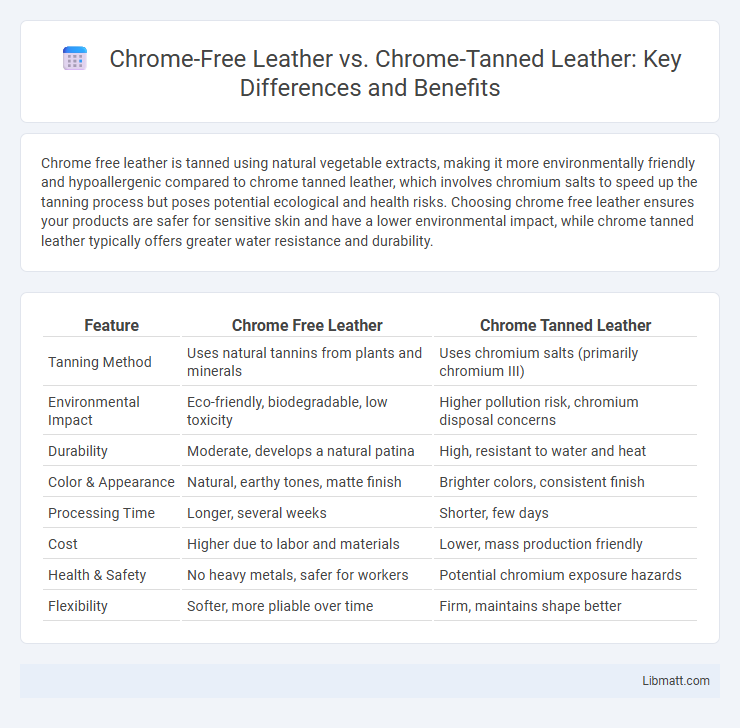Chrome free leather is tanned using natural vegetable extracts, making it more environmentally friendly and hypoallergenic compared to chrome tanned leather, which involves chromium salts to speed up the tanning process but poses potential ecological and health risks. Choosing chrome free leather ensures your products are safer for sensitive skin and have a lower environmental impact, while chrome tanned leather typically offers greater water resistance and durability.
Table of Comparison
| Feature | Chrome Free Leather | Chrome Tanned Leather |
|---|---|---|
| Tanning Method | Uses natural tannins from plants and minerals | Uses chromium salts (primarily chromium III) |
| Environmental Impact | Eco-friendly, biodegradable, low toxicity | Higher pollution risk, chromium disposal concerns |
| Durability | Moderate, develops a natural patina | High, resistant to water and heat |
| Color & Appearance | Natural, earthy tones, matte finish | Brighter colors, consistent finish |
| Processing Time | Longer, several weeks | Shorter, few days |
| Cost | Higher due to labor and materials | Lower, mass production friendly |
| Health & Safety | No heavy metals, safer for workers | Potential chromium exposure hazards |
| Flexibility | Softer, more pliable over time | Firm, maintains shape better |
Introduction to Leather Tanning Methods
Chrome free leather relies on vegetable or aldehyde-based tanning agents, offering an eco-friendly alternative to chrome tanned leather, which uses chromium salts to speed up the tanning process. Chrome tanned leather is known for its durability, water resistance, and softness, while chrome free leather emphasizes sustainability and reduced environmental impact. Choosing your leather type depends on balancing performance needs with ecological considerations in your products.
What Is Chrome Tanned Leather?
Chrome tanned leather is treated with chromium salts, primarily chromium sulfate, which accelerates the tanning process to produce soft, durable, and water-resistant material. This method enhances the leather's flexibility and color retention compared to traditional vegetable tanning techniques. Your choices in leather goods can benefit from chrome tanning's balance of strength and comfort, making it a popular option for garments, footwear, and upholstery.
What Is Chrome Free Leather?
Chrome free leather is tanned using natural agents like vegetable extracts instead of chromium salts, making it more environmentally friendly and biodegradable. Unlike chrome tanned leather, which uses chromium(III) compounds for faster processing and enhanced durability, chrome free leather avoids heavy metals that pose ecological and health risks. This method results in leather with a more natural appearance, greater breathability, and better biodegradability while maintaining strength suitable for sustainable fashion and accessories.
Key Differences Between Chrome Free and Chrome Tanned Leather
Chrome-free leather is tanned using natural, vegetable-based tannins, resulting in an eco-friendly and biodegradable product with a more rigid texture and unique aroma. Chrome-tanned leather uses chromium salts in the tanning process, producing softer, more pliable leather with higher water resistance and durability. The key differences lie in environmental impact, softness, and chemical composition, making chrome-free leather preferable for sustainable goods and chrome-tanned leather ideal for mass-produced, flexible leather items.
Advantages of Chrome Tanned Leather
Chrome tanned leather offers superior durability and resistance to water, heat, and stains compared to chrome-free leather, making it ideal for everyday products like shoes, bags, and upholstery. The chrome tanning process enhances the leather's softness and flexibility while preserving its strength, allowing for a longer-lasting and more comfortable material. This type of leather also requires less drying time and resists shrinkage, contributing to efficient manufacturing and consistent quality in finished goods.
Benefits of Chrome Free Leather
Chrome free leather offers significant environmental benefits by avoiding harmful chromium chemicals, leading to safer production and reduced pollution. This type of leather is hypoallergenic and safer for individuals with sensitive skin, making it a healthier choice for your products. Its natural tanning process allows for better biodegradability without sacrificing durability or appearance.
Environmental Impact: Chrome Free vs Chrome Tanned
Chrome-free leather significantly reduces environmental pollution by avoiding the use of toxic chromium salts commonly found in chrome-tanned leather, which can contaminate water sources and soil. Your choice of chrome-free leather supports more sustainable tanning processes that utilize natural tannins and produce less hazardous waste, promoting safer working conditions and lower ecological footprints. The biodegradability of chrome-free leather is higher, making it a preferred option for eco-conscious consumers seeking to minimize environmental impact.
Durability and Performance Comparison
Chrome-free leather, crafted without chromium salts, offers excellent breathability and develops a natural patina over time but generally exhibits lower resistance to water, stains, and wear compared to chrome-tanned leather. Chrome-tanned leather, treated with chromium salts, provides superior durability, enhanced flexibility, and higher resistance to heat and moisture, making it ideal for heavy-duty or everyday items requiring long-lasting performance. Your choice between these leathers impacts the lifespan and maintenance of products, with chrome-tanned leather delivering greater robustness for demanding environments.
Health and Safety Considerations
Chrome-free leather eliminates the use of toxic chromium salts, reducing potential health risks associated with chemical exposure during tanning and use. Chrome-tanned leather, while durable and water-resistant, can release chromium VI, a known allergen and carcinogen, posing safety concerns over prolonged contact. Choosing chrome-free leather minimizes your exposure to harmful substances, promoting a safer and more environmentally friendly option for your health.
Choosing the Best Leather for Your Needs
Chrome-free leather offers a natural, eco-friendly alternative to traditional chrome tanned leather, which is processed using chromium salts for enhanced durability and water resistance. Selecting the best leather depends on your priorities: choose chrome-free leather for sustainability and a more natural aging process, or opt for chrome tanned leather if you need higher resistance to wear and moisture. Understanding these differences ensures the right balance between environmental impact, aesthetics, and performance in leather products.
Chrome free leather vs chrome tanned leather Infographic

 libmatt.com
libmatt.com